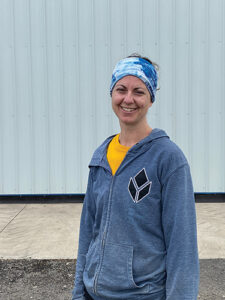How’s the weather?
Jennie Parsonage
Baldur, Manitoba
Jennie Parsonage farms with her husband and runs an aerial spraying company, Air Greenway, with her sister and brothers. Weather monitoring is extra important for the spraying business. They use a paid version of the Windy app, which provides wind speed and direction (and temperature) for a large area at once. Blue tinted areas on the map are good spraying conditions, green is OK and orange and red areas are too windy. “This gives us a quick reference from home base on where we can go to get a couple of fields sprayed,” Parsonage says.
“This gives us a quick reference from home base on where we can go to get a couple of fields sprayed.”
Jennie Parsonage in reference to the Windy app
The Windy app also provides a wind forecast up to nine days into the future, although Parsonage rarely looks beyond one day at a time.
The Parsonage farm also has its own Davis weather station and taps into the Davis WeatherLink network, which has 20 stations within the area they fly. “This gives us real-time data on gusts,” Parsonage says, although accuracy depends on where farmers put their stations. “Stations in the yard are not helpful for wind. We were going to spray near one farm that I knew had a station. It was reading two km/h of wind. I phoned and asked if that was accurate, and he said he just parked the super B truck beside the station.”
Manitoba Agriculture has weather stations all across the province that provide updates every 15 minutes from 7 a.m. to 5 p.m. Parsonage emailed and asked if they could provide updates until 10 p.m. for the stations closest to their farm. They made the change. “I thought that was pretty responsive for a government agency.”
Finally, they check Global News SkyTracker and Environment Canada for weather radars.
Amanda and Curt Hazlett
Red Deer, Alberta
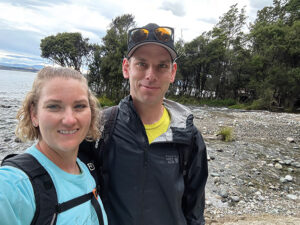
Amanda and Curt Hazlett farm with Curt’s father and his wife at three locations – the home farm just east of Red Deer, another block of land 45 minutes south, near Bowden, and a third block 30 minutes east, near Delburne. With land so spread out, “we lean into our neighbours” for weather updates, Amanda says.
“With land so spread out, ‘we lean into our neighbours’ for weather updates. ”
Amanda Hazlett
The neighbour network may sound old fashioned, but it’s accurate and timely. It tells the Hazletts what’s actually happening on the ground. Weather conditions and hail risk from farm site to farm site are different enough that they need three separate insurance policies, Amanda says.
The Hazletts also use Environment Canada weather radar to check the size and direction of weather systems. But systems often seem to make sharp turns when they get to the Red Deer River valley, so their farm seems to miss some rains, Amanda says.
Landscape also makes for extremely localized weather that would not show up on a general forecast. If it’s too windy in the yard, they can usually spray fields down in the river valley, Curt says, which is 250 feet lower and sheltered. Their fields in the river flats don’t have any neighbouring fields either.
Walking fields is another important weather measure. Amanda often takes their kids, three and five, scouting to check weeds, crop stage, field conditions and disease risk. They also check if the ground is firm enough for the sprayer. “One other resource I look at is Richardson’s risk pressure map for sclerotinia,” Amanda says.
As for planning around the weather, “we shouldn’t even consider long-term weather forecasting in our area,” Curt says.
Ryan Gauthier
Donnelly, Alberta
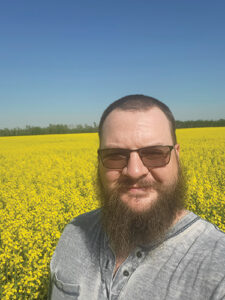
Ryan Gauthier triangulates among three weather apps “trying to find the average,” he says. “It can happen that none predict the same thing.”
The apps are Weather Network, Weather Channel and Environment Canada.
He also considers “old wives’ tales”, especially the one about two or three days of wind from the east bringing rain. “It’s incredible how accurate that is,” Gauthier says.
“It’s incredible how accurate that is.”
Ryan Gauthier in reference to the “old wives’ tale” about two or three days of wind from the east bringing rain.
The yard has a wind vane wired to a small monitor on the side of the shed to show wind speed and direction. “I also have a wind sock to confirm the vane is still working,” he says.
For Gauthier, the key weather reports are wind speed and heat for spraying decisions. He wants hot days for Liberty, and when Canola Digest talked to him in early July, highs for the season were barely getting above 17°C. “So I spray Roundup in the morning and hope it gets warm enough in the afternoon to spray one field with Liberty,” he says. “I don’t want to spray Liberty at 10°C.”
Jonah McGrath
Leroy, Saskatchewan
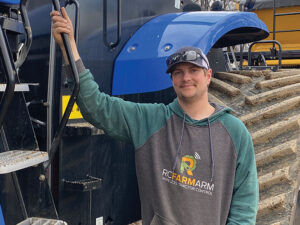
Jonah McGrath added two new tools to his weather monitoring this year – an Amazon Vevor mini weather station and the Davis WeatherLink app.
The low-cost Vevor unit measures humidity, precipitation, temperature, wind speed and wind direction, and relays that to a display in the house or shop.
“There is nothing more honest than that.”
Jonah McGrath in reference to his good ol’ plastic rain gauge.
WeatherLink is a free phone app that taps into a network of weather stations. McGrath can get updates from the a station at the nearby BHP Billiton potash mine and another about 20km in the other direction. With most of his land between these two stations, McGrath gets two different and fairly detailed reports. If hail is moving in from either direction, for example, he can move equipment into shelter or perhaps make a quick call to the hail insurance broker, McGrath says.
Rounding out his weather tools are a standard weather app, with radar, on his phone and a rain gauge. “There is nothing more honest than that,” McGrath says.
Andrea De Roo
Fairlight, Saskatchewan

Andrea De Roo’s off-farm job is director of agronomy with Crop Intelligence, a Saskatchewan company that supports in-season decision making using weather stations and soil moisture probes. De Roo has three on her farm.
She puts stations into fields after seeding. A key feature for her is the soil moisture probe. It measures soil moisture at various depths. Farmers can monitor root activity by watching how soil moisture changes over time. For example, if water levels at 50cm depth start to go down, you can assume the roots have reached that depth. “We use soil moisture measurements in the fall to set yield goals and crop rotations,” De Roo says. “In-season top dressing is also a big part of our program.”
“We use soil moisture measurements in the fall to set yield goals and crop rotations. In-season top dressing is also a big part of our program.”
Andrea De Roo
For example, this year they fertilized for a 70 bu./ac. wheat crop but conditions as of early July suggested a potential 100 bu./ac. crop. So they top dressed with a liquid fertilizer mix of UAN and ammonium thiosulphate at rates of 25-30 lb./ac. of actual nitrogen and six to eight of actual sulphur. “With this rate on wheat, we can usually count on another 10 bu./ac. and a boost in protein.”
They will also top-dress canola with a similar rate and expected yield bump.
“We used to run fully replicated trials to see if the top dress worked. It did, so we don’t need to do them anymore,” De Roo says.
The weather station also logs temperature and rainfall. It tracks the degree and length of a frost event, to give a severity rating, it tracks growing degree days so farms can estimate crop growth stage, and it gives a Delta T indication of spray conditions. Delta T is an indicator of water evaporation rate. You don’t want it too high or too low.
As for other weather services, De Roo uses the Windy app, which shows wind speed and direction, including at different elevations. That is useful when flying drones. Windy forecasts wind for later in the day, tomorrow and possibly the following day with some accuracy, De Roo says.
She also listens to weather forecasters at all the winter meetings. “Although you have to take those with a grain of salt,” she says. “This spring was so different from what people forecasted.”
Owen Orsak
Binscarth, Manitoba
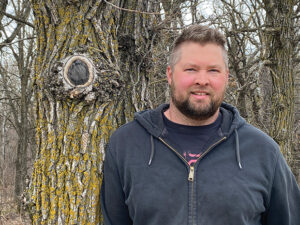
Owen Orsak has a 65-foot spruce tree in the farm yard and “if the top is moving, it’s probably too windy to spray,” he says. “If all the grass in the ditch is bent over in the same direction, it’s probably too windy to spray. If canola leaves are flipping so you can see the lighter coloured undersides, it’s probably too windy to spray.” These wind indicators, based on years of family history on the farm, are just as valuable as a weather app, Orsak says.
“If all the grass in the ditch is bent over in the same direction, it’s probably too windy to spray. If canola leaves are flipping so you can see the lighter coloured undersides, it’s probably too windy to spray.”
Owen Orsak
Spraying season is when he checks weather the most. This was their first full year with a sprayer with pulse width modulation, which gives some droplet size control. “With larger droplets, we can handle a bit more wind,” he says.
Also new for this year, the farm has a field-based Ukko Agro weather station set up in conjunction with Syngenta. It measures rainfall, humidity, temperature, wind speed and direction. It relays this information to Orsak’s phone. “I could get messages every 30 minutes if I wanted,” he says. “I can check how much rain fell overnight without leaving my bed. If fields will be too wet for the sprayer, I can stay in bed.”
Sygenta uses the stations to help farmers make fungicide decisions. Orsak doesn’t usually spray canola for sclerotinia stem rot, but will often spray wheat to protect it from fusarium head blight. When Canola Digest talked with him in early July, the farm had tallied 12” (294mm) of rain from April 15 and the “planes were flying right now” applying fungicide.
As for seasonal rainfall predictions, Orsak knows his area is likely to get rain. The benefit of soil moisture probes and long-range weather forecasts are to set yield expectations and fertilizer rates. Orsak plans for good average yields and always fertilizes accordingly. He deep bands at seeding, so if the crop is light and doesn’t use it all that year, it will be available for next year.
He thinks in-season soil moisture probes would just stress him out unnecessarily. “Unless you have irrigation pivots, what are you going to do with that information?,” he says.





